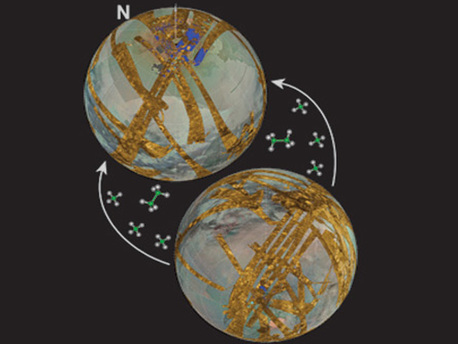Mystery Solved
Puzzling Lake Asymmetry on Titan
 © NASA/JPL/Caltech/UA/SSI |
The northern and southern hemispheres of Titan, showing the great disparity between the abundance of lakes in the north and their paucity in the south. The hypothesis presented favors long-term flux of volatile hydrocarbons, predominantly methane, from hemisphere to hemisphere. Recently, the direction of transport has been from south to north, but the effect would have reversed tens of thousands of years ago
- » 1 -
- » 2 - The New Theory
The Status Quo
Saturn's oblong orbit around the sun exposes different parts of Titan to different amounts of sunlight, which affect cycles of precipitation and evaporation in those areas. Similar variations in Earth's orbit also drive long-term ice-age cycles on our planet.As revealed by Synthetic Aperture Radar imaging data from NASA's Cassini spacecraft, liquid methane and ethane lakes in Titan's northern high latitudes cover 20 times more area than lakes in the southern high latitudes. The Cassini data also show there are significantly more partially filled and now-empty lakes in the north. (In the radar data, smooth features - like the surfaces of lakes - appear as dark areas, while rougher features - such as the bottom of an empty lake - appear bright.) The asymmetry is not likely to be a statistical fluke because of the large amount of data collected by Cassini in its five years surveying Saturn and its moons.
Scientists initially considered the idea that "there is something inherently different about the northern polar region versus the south in terms of topography, such that liquid rains, drains or infiltrates the ground more in one hemisphere," said Oded Aharonson of Caltech.
However, Aharonson notes that there are no substantial known differences between the north and south regions to support this possibility. Alternatively, the mechanism responsible for this regional dichotomy may be seasonal. One year on Titan lasts 29.5 Earth years. Every 15 Earth years, the seasons of Titan reverse, so that it becomes summer in one hemisphere and winter in the other. According to this seasonal variation hypothesis, methane rainfall and evaporation vary in different seasons - recently filling lakes in the north while drying lakes in the south.
The problem with this idea, Aharonson said, is that it accounts for decreases of about one meter per year in the depths of lakes in the summer hemisphere. But Titan's lakes are a few hundred meters deep on average, and wouldn't drain (or fill) in just 15 years. In addition, seasonal variation can't account for the disparity between the hemispheres in the number of empty lakes. The north polar region has roughly three times as many dried-up lake basins as the south and seven times as many partially filled ones.
Mystery Solved
Puzzling Lake Asymmetry on Titan
 © NASA/JPL/Caltech/UA/SSI |
The northern and southern hemispheres of Titan, showing the great disparity between the abundance of lakes in the north and their paucity in the south. The hypothesis presented favors long-term flux of volatile hydrocarbons, predominantly methane, from hemisphere to hemisphere. Recently, the direction of transport has been from south to north, but the effect would have reversed tens of thousands of years ago
- » 1 -
- » 2 - The New Theory
The Status Quo
Saturn's oblong orbit around the sun exposes different parts of Titan to different amounts of sunlight, which affect cycles of precipitation and evaporation in those areas. Similar variations in Earth's orbit also drive long-term ice-age cycles on our planet.As revealed by Synthetic Aperture Radar imaging data from NASA's Cassini spacecraft, liquid methane and ethane lakes in Titan's northern high latitudes cover 20 times more area than lakes in the southern high latitudes. The Cassini data also show there are significantly more partially filled and now-empty lakes in the north. (In the radar data, smooth features - like the surfaces of lakes - appear as dark areas, while rougher features - such as the bottom of an empty lake - appear bright.) The asymmetry is not likely to be a statistical fluke because of the large amount of data collected by Cassini in its five years surveying Saturn and its moons.
Scientists initially considered the idea that "there is something inherently different about the northern polar region versus the south in terms of topography, such that liquid rains, drains or infiltrates the ground more in one hemisphere," said Oded Aharonson of Caltech.
However, Aharonson notes that there are no substantial known differences between the north and south regions to support this possibility. Alternatively, the mechanism responsible for this regional dichotomy may be seasonal. One year on Titan lasts 29.5 Earth years. Every 15 Earth years, the seasons of Titan reverse, so that it becomes summer in one hemisphere and winter in the other. According to this seasonal variation hypothesis, methane rainfall and evaporation vary in different seasons - recently filling lakes in the north while drying lakes in the south.
The problem with this idea, Aharonson said, is that it accounts for decreases of about one meter per year in the depths of lakes in the summer hemisphere. But Titan's lakes are a few hundred meters deep on average, and wouldn't drain (or fill) in just 15 years. In addition, seasonal variation can't account for the disparity between the hemispheres in the number of empty lakes. The north polar region has roughly three times as many dried-up lake basins as the south and seven times as many partially filled ones.





